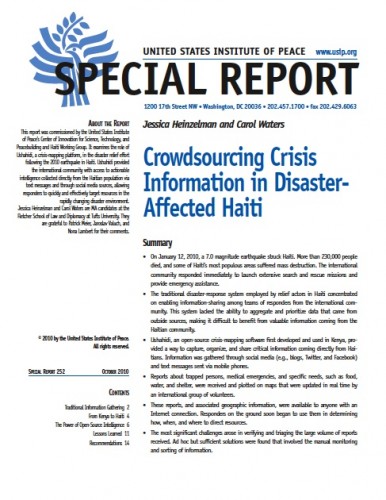As many fans and supporters of Ushahidi recall, the Ushahidi−Haiti Project raised the profile of crisis mapping to a new level. It demonstrated the potential of crowdsourced maps for targeted disaster response to a broad and empowered audience and provided a useful foundational model for the international community to leverage and improve upon in advance of future emergencies.
To many outside the core team of volunteers working day and night for weeks out of a basement at the Fletcher School of Law & Diplomacy in Boston, the logistics of the Ushahidi-Haiti were a mystery. How did they get such detailed maps? Who is translating and mapping each SMS? How are people using the information on the ground?
My co-author, Carol Waters, and I are excited to share the recent report published by the United States Institute of Peace (USIP), "Crowdsourcing Crisis Information in Disaster-Affected Haiti." It provides an overview of the project from platform launch to hand-off. The mystery is revealed!
Full version of the report available on the USIP website
Many thanks to all the people involved with the project who graciously agreed to interviews and replied to our emails and to USIP for not only publishing the report, but giving $20,000 to the Ushahidi-Haiti effort during the crisis.
Summary of the Report:
- On January 12, 2010, a 7.0 magnitude earthquake struck Haiti. More than 230,000 people died, and some of Haiti’s most populous areas suffered mass destruction. The international community responded immediately to launch extensive search and rescue missions and provide emergency assistance.
- The traditional disaster-response system employed by relief actors in Haiti concentrated on enabling information-sharing among teams of responders from the international community. This system lacked the ability to aggregate and prioritize data that came from outside sources, making it difficult to benefit from valuable information coming from the Haitian community.
- Ushahidi, an open-source crisis-mapping software first developed and used in Kenya, provided a way to capture, organize, and share critical information coming directly from Haitians. Information was gathered through social media (e.g., blogs, Twitter, and Facebook) and text messages sent via mobile phones.
- Reports about trapped persons, medical emergencies, and specific needs, such as food, water, and shelter, were received and plotted on maps that were updated in real time by an international group of volunteers.
- These reports, and associated geographic information, were available to anyone with an Internet connection. Responders on the ground soon began to use them in determining how, when, and where to direct resources.
- The most significant challenges arose in verifying and triaging the large volume of reports received. Ad hoc but sufficient solutions were found that involved the manual monitoring and sorting of information.
